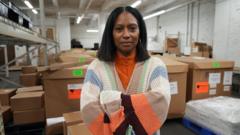Live shopping, an interactive blend of entertainment and e-commerce, is gaining traction in the U.S. and Europe, but its future remains uncertain as analysts weigh its sustainability against established shopping habits.
**The Rise of Live Shopping: A Trend on the Horizon?**

**The Rise of Live Shopping: A Trend on the Horizon?**
Exploring the potential and pitfalls of the emerging live shopping industry.
The concept of live shopping is not new, but it is making significant inroads in Western markets as brands seek innovative ways to capture consumer interest. One such pioneer is Kelsey Krakora, a former bartender who transitioned to selling clothes through platforms like Whatnot and Poshmark. Since her first live show in November 2022, where she struggled to make sales, she has transformed her approach and now averages $1,000 in sales per session, showcasing around 100 items in three-hour live streams.
Often compared to traditional shopping channels like QVC, live shopping allows for a more immediate and interactive buying experience, harnessing the power of social media to engage viewers directly. As younger generations veer away from cable access, live shopping offers a modern alternative—a trend that has already been embraced in Asia-Pacific markets, notably through platforms like Douyin.
In the United States, the live shopping sector is projected to be worth $32 billion, with fashion, cosmetics, and collectibles emerging as the most popular categories. A survey by VTEX indicated that 45% of American consumers had engaged in live shopping over the past year. Rising interest was notably linked to the introduction of short video formats on platforms like Instagram and YouTube, which enhanced the appeal of live shopping events.
However, not everyone believes live shopping will become a sustainable long-term solution. Some experts point to the challenges posed by the distinct shopping culture in the U.S., which is characterized by a preference for in-store experiences where consumers can try on clothing or assess products firsthand. Moreover, established influencers or 'key opinion leaders' in places like China may not have a direct analog in the U.S. market, potentially hindering the effectiveness of live shopping.
Despite skepticism, the trend has attracted the attention of numerous major brands. Companies like Nordstrom, Kit Kat, and Samsung have already engaged in live shopping, reflecting a broader industry shift. The excitement generated by live interactions is unparalleled, according to Poshmark CEO Manish Chandra, creating a community atmosphere that distinguishes this approach from traditional commerce.
High-end brands are also capitalizing on the trend. Amouage, a niche fragrance house, has successfully executed live shopping events in China and is now looking to replicate that success in the U.S. market through Nordstrom. This shift allows for immediate consumer feedback, helping marketers adapt products to better meet consumer demands.
In a landscape where shopping can quickly become a compulsive habit, the potential for live shopping is both promising and precarious, igniting interest from consumers and businesses alike while challenging established retail norms. As the sector evolves, it remains to be seen whether it will become a fixture in the shopping experience or remain a niche market.
















